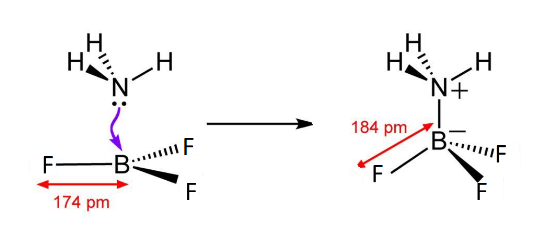
The formation of molecular complex
(A) From
(B) From
(C) From
(D) From
Answer
141.9k+ views
Hint:
Complete step-by-step solution:
While,
So, when they come close to each other to form a bond, an ammonia molecule coordinates its lone pair to the empty p-shell or vacant p-orbitals of Boron forming a co-ordinate bond to give rise to an adduct which looks like this.

Hence, the correct option is (B).
Note: As per molecular orbital theory, one can also understand this concept as the HOMO on the Lewis base (
Complete step-by-step solution:
While,
So, when they come close to each other to form a bond, an ammonia molecule coordinates its lone pair to the empty p-shell or vacant p-orbitals of Boron forming a co-ordinate bond to give rise to an adduct which looks like this.

Hence, the correct option is (B).
Note: As per molecular orbital theory, one can also understand this concept as the HOMO on the Lewis base (
Recently Updated Pages
Difference Between Crystalline and Amorphous Solid

JEE Main Participating Colleges 2024 - A Complete List of Top Colleges

JEE Main Maths Paper Pattern 2025 – Marking, Sections & Tips

Sign up for JEE Main 2025 Live Classes - Vedantu

JEE Main 2025 Helpline Numbers - Center Contact, Phone Number, Address

JEE Main Course 2025 - Important Updates and Details

Trending doubts
JEE Main 2025 Session 2: Application Form (Out), Exam Dates (Released), Eligibility, & More

JEE Main Exam Marking Scheme: Detailed Breakdown of Marks and Negative Marking

JEE Main 2025: Derivation of Equation of Trajectory in Physics

Electric Field Due to Uniformly Charged Ring for JEE Main 2025 - Formula and Derivation

Types of Solutions

Learn About Angle Of Deviation In Prism: JEE Main Physics 2025

Other Pages
JEE Advanced Marks vs Ranks 2025: Understanding Category-wise Qualifying Marks and Previous Year Cut-offs

JEE Advanced 2025: Dates, Registration, Syllabus, Eligibility Criteria and More

NCERT Solutions for Class 11 Chemistry Chapter 5 Thermodynamics

Hydrocarbons Class 11 Notes: CBSE Chemistry Chapter 9

JEE Advanced Weightage 2025 Chapter-Wise for Physics, Maths and Chemistry

NCERT Solutions for Class 11 Chemistry In Hindi Chapter 1 Some Basic Concepts of Chemistry




